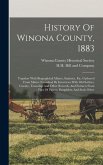Winona County, located in the Driftless Area of southeastern Minnesota, was organized in 1854 by an act of the territorial legislature. Following treaties with the local Native Americans, many eastern farmers came to the frontier to settle on a rich land obtained through a system of land transfers called patents. As the area opened to the settlers, railroads were provided with land on which to lay track across the county to bring farm products to market and carry supplies to the interior. In addition to the railroads, roadways were established and villages sprang up at regular intervals where businessmen settled to provide goods and services locally. Scattered throughout the county, churches and cemeteries were established, and one-room schoolhouses were built. As the county entered the 20th century, a system of commerce had been well established, and goods and services easily flowed about the area. However, the 20th century was also a time of change; new technologies were developed, some farms grew while other disappeared, some villages died, and the old ways were cast aside. Winona County uses rarely viewed images from the collections of the Winona County Historical Society.








